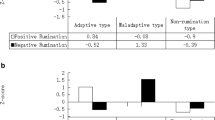Abstract
Response Style Theory [S. Nolen-Hoeksema (1987) “Sex Differences in Unipolar Depression: Evidence and Theory,” Psychological Bulletin, Vol. 101, pp. 259–282] suggests that, when depressed, women ruminate on their sad feelings while men distract themselves from theirs. We sought to examine this gender difference in more detail. In Study 1, 155 students provided stereotype ratings or self-reports of responses to depression. The stereotype ratings conformed precisely to Response Style Theory yet exaggerated self-reported gender differences, especially for men. In Study 2, 40 roommate pairs completed a similar set of ratings. Again, other-ratings conformed exactly to Response Style Theory's predictions while self-ratings showed a more moderated pattern. In both studies, women reported ruminating more than did men, yet men and women were equally likely to report distraction. We conclude by examining several hypotheses for the discrepancies between stereotypes and self-reports for men as well as the increased rates of rumination among women.
Similar content being viewed by others
REFERENCES
Broverman, I., Broverman, D., Clarkson, F., Rosenkrantz, P., & Vogel, S. (1970). Sex-role stereotypes and clinical judgments of mental health. Journal of Consulting and Clinical Psychology, 34, 1–7.
Butler, L. D., & Nolen-Hoeksema, S. (1994). Gender differences in responses to depressed mood in a college sample. Sex Roles, 30, 331–346.
Carver, C. S., & Scheier, M. F. (1981). Attention and self-regulation: A control-theory approach to human behavior. New York: Springer.
Cohen, J., & Cohen, P. (1975). Applied multiple regression/correlation analysis for the behavioral sciences. Hillsdale, NJ: Lawrence Erlbaum.
Conway, M., Giannopoulos, C., & Stiefenhofer, K. (1990). Response styles to sadness are related to sex and sex-role orientation. Sex Roles, 22, 579–597.
Fujita, F., Diener, E., & Sandvik, E. (1991). Gender differences in negative affect and wellbeing: The case for emotional intensity. Journal of Personality and Social Psychology, 61, 427–434.
Grossman, M., & Wood, W. (1993). Sex differences in intensity of emotional experience: a social role interpretation. Journal of Personality and Social Psychology, 65, 1010–1022.
Hamilton, J. A., Alagna, S. W., King, L. S., & Lloyd, C. (1987). The emotional consequences of gender-based abuse in the workplace: New counseling programs for sex discrimination. Women and Therapy, 6, 155–182.
Hammen, C. L., & Padesky, C. A. (1977). Sex differences in the expression of depressive responses on the Beck Depression Inventory. Journal of Abnormal Psychology, 86, 609–614.
Hammen, C. L., & Peters, S. D. (1977). Differential responses to male and female depressive reactions. Journal of Consulting and Clinical Psychology, 45, 994–1001.
Howard, G. (1991). Culture tales: A narrative approach to thinking, cross-cultural psychology, and psychotherapy. American Psychologist, 46, 187–197.
Ingram, R. E. (1984). Toward an information-processing analysis of depression. Cognitive Therapy and Research, 8, 443–478.
Ingram, R. E., Cruet, D., Johnson, B. R., & Wisnicki, K. S. (1988). Self-focused attention, gender, gender role, and vulnerability to negative affect. Journal of Personality and Social Psychology, 55, 967–978.
Kaplan, A. (1986). The “self-in-relation”: Implications for depression in women. Psychotherapy, 23, 234–242.
Kaplan, M. (1983). A woman's view of DSM-III. American Psychologist, 38, 786–792.
Kupers, T. (1993). Revisioning men's lives: gender, intimacy, and power. New York: Guilford Press.
Levant, R. (1996). The new psychology of men. Professional Psychology, 27, 259–265.
Lyubomirsky, S., & Nolen-Hoeksema, S. (1993). Self-perpetuating properties of dysphoric rumination. Journal of Personality and Social Psychology, 65, 339–349.
Morrow, J., & Nolen-Hoeksema, S. (1990). The effects of responses to depression on remediation of depressive affect. Journal of Personality and Social Psychology, 58, 519–527.
Nolen-Hoeksema, S. (1987). Sex differences in unipolar depression: Evidence and theory. Psychological Bulletin, 101, 259–282.
Nolen-Hoeksema, S. (1990). Sex differences in depression. Stanford, CA: Stanford University Press.
Nolen-Hoeksema, S., Morrow, J., & Fredrickson, B. L. (1993). Response styles and the duration of episodes of depressed mood. Journal of Abnormal Psychology, 102, 20–28.
Phillips, R. D., & Gilroy, F. D. (1985). Sex-role stereotypes and clinical judgments of mental health: The Brovermans' findings reexamined. Sex Roles, 12, 179–193.
Rubinow, D. R., & Roy-Byrne, P. (1984). Premenstrual syndromes: Overview from a methodologic perspective. American Journal of Psychiatry, 141, 163–172.
Seidler, V. J. (1989). Rediscovering masculinity: reason, language, and sexuality. New York: Routledge.
Weissman, M. M., & Klerman, G. L. (1977). Sex differences in the epidemiology of depression. Archives of General Psychology, 25, 1304–1311.
Widiger, T. A., & Settle, S. A. (1987). Broverman et al. revisited: An artifactual gender bias. Journal of Personality and Social Psychology, 53, 463–469.
Wood, J., Saltzberg, J., Neale, J. M., Stone, A. A., & Rachmiel, T. B. (1990). Self-focused attention, coping responses, and distressed mood in everyday life. Journal of Personality and Social Psychology, 58, 1027–1036.
Wood, W., Rhodes, N., & Whelan, M. (1989). Sex differences in positive well-being: A consideration of emotional style and marital status. Psychological Bulletin, 106, 249–264.
Author information
Authors and Affiliations
Rights and permissions
About this article
Cite this article
Strauss, J., Muday, T., McNall, K. et al. Response Style Theory Revisited: Gender Differences and Stereotypes in Rumination and Distraction. Sex Roles 36, 771–792 (1997). https://doi.org/10.1023/A:1025679223514
Issue Date:
DOI: https://doi.org/10.1023/A:1025679223514



